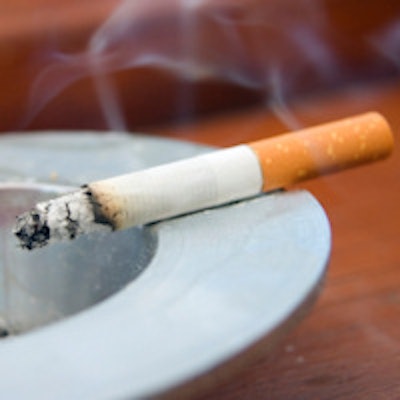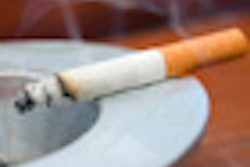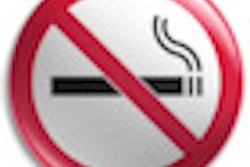
A possible causal relationship may exist between secondhand smoke (SHS) and caries in the primary dentition in children, according to a review of studies recently published in the International Journal of Environmental Research and Public Health (December 5, 2014).
However, more research is needed before secondhand smoke can be considered a risk factor for caries, the Japanese researchers concluded.
The researchers reviewed 15 studies that examined how lifestyle, household environment, and the caries score of Japanese children at age 1.5 years affected their dental caries incidence at age 3. Dental examinations were completed for 31,202 children who participated in routine dental examinations at age 1.5; the exam was repeated approximately 21 months later (at age 3).
The analysis indicated a strong association of the consumption of sugar-sweetened beverages/snacks, less frequent toothbrushing by the parents, lack of fluoride varnish, and a family history of smoking with the risk of developing dental caries.
Surveys showed that between 1989 and 2012, the prevalence of dental caries in young Japanese children (age 3) showed a striking decrease from 55.8% to 19.1%. However, the researchers noted, caries rates increased dramatically between the time the children were 18 months old and when they turned 3 years old.
"To understand why there is a large difference in dental caries between children at 18 months and 3 years old is an important public health issue," the researchers noted.
Regarding the household environment, nearly half of the children in the study had family members who lived with them and smoked (44.8%). The incidence of dental caries in 3-year-old children was significantly different between boys (17.3%) and girls (15.4%). The incidence of dental caries differed dramatically among children who had been breast-fed (24.6%) and those who were not breast-fed (14.2%). In addition, children who did not receive fluoride varnish had a higher incidence of caries (23.1%), especially in boys (24.8% versus 21.5% for girls).
This backs up a 2011 systematic review that confirmed the association of secondhand smoke with early childhood caries (Int J Environ Res Public Health, May 12, 2011, Vol. 8:5, pp. 1503-1519). An earlier in vitro study found that environmental tobacco smoke exposure increased the growth of cariogenic bacteria (Mutans streptococcus) that can convert carbohydrates into acids (Journal of the American Dental Association, November 1981, Vol. 103:5, pp. 719-722).
Results
Children living with family members who smoked had a higher incidence of dental caries (19.9%) than children living with family members who did not smoke (13.5%).
"The evidence is insufficient to demonstrate a causal relationship between SHS and caries in the permanent dentition," the researchers concluded. "It is not yet time to declare that SHS is a risk factor for caries."
They advised using methodological approaches to better understand the possible association between SHS and caries. In addition, the researchers recommend studying the relationship between pregnant mothers who smoke and caries in the permanent dentition of children.
Previous commentary
David Leader, DMD, MPH, an associate clinical professor at the Tufts University School of Dental Medicine in Boston, previously wrote a critical summary assessment of the 2011 review for the Journal of the American Dental Association (February 2014, Vol. 145:2, pp. 179-181).
“Regardless of the nature of the association with caries ... oral healthcare providers are in an advantageous position to provide tobacco-use cessation counseling.”
"As dentistry moves from surgical treatment of caries to prevention and risk-based medical management, it becomes more important to understand behaviors that are associated with a higher risk of developing caries," Dr. Leader wrote. "SHS may be such a risk, but more research is required to establish causality."
One way to determine if secondhand smoke is a risk factor for caries would be to look for evidence of exposure to nicotine in the blood of young children, according to Dr. Leader. Only one of the studies in the previous review took the extra step of measuring the levels of cotinine, a byproduct of nicotine, in the children's blood to see how much smoke they had been exposed to, he noted.
"Risk factors for high caries risk include low socioeconomic status, a diet high in refined carbohydrates, low fluoride exposure, and poor or infrequent oral hygiene," Dr. Leader wrote. "Researchers in this systematic review investigated whether SHS is another risk factor. If true, this risk factor would be within the ability of parents and guardians to moderate."
But he added that secondhand smoke may simply be a marker for low socioeconomic status and poor health choices, but he noted that the authors of the 2011 systematic review asserted the studies demonstrated a statistically significant increase in caries risk even after adjusting for environmental factors.
"Regardless of the nature of the association with caries, tobacco use and SHS are severe health risks, and oral healthcare providers are in an advantageous position to provide tobacco-use cessation counseling," he concluded.



















